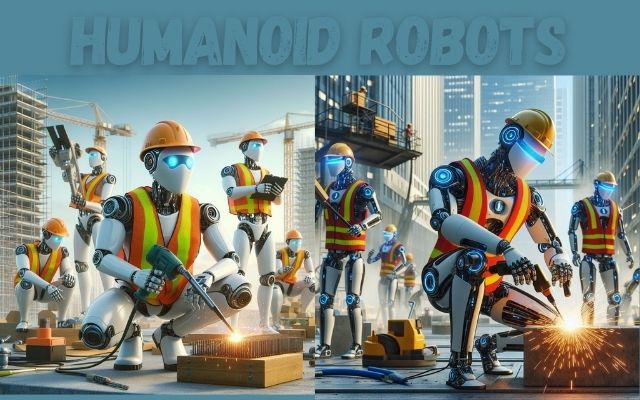Humanoid Robots Are Getting To Work

In the realm of technology, humanoid robots have emerged as a fascinating and transformative innovation. These robots, designed to mimic human form and behavior, are no longer confined to the realms of science fiction. Today, they are a reality, increasingly finding their place in various sectors of the workforce.
The advent of humanoid robots in the workplace marks a significant shift in how tasks are performed. From manufacturing to customer service, these robots are being employed to carry out tasks with a level of precision and efficiency that was previously unattainable.
But what exactly are humanoid robots? In simple terms, they are robots that resemble humans not just in appearance, but also in their functionality. They are designed to interact with their environment and carry out tasks in a way that is similar to how a human would.
The integration of humanoid robots into the workforce has the potential to bring about profound changes. On one hand, they can increase productivity, reduce errors, and perform tasks that may be dangerous for humans. On the other hand, their introduction raises important questions about job displacement and the future of human work.
This article aims to delve into the world of humanoid robots at work, exploring their roles, impacts, and the future they are shaping. As we stand on the brink of this robotic revolution, it’s time to understand and navigate the changes that are underway.
The Rise of Humanoid Robots
The world of technology is witnessing a significant shift with the rise of humanoid robots. These robots, designed to resemble and act like humans, are increasingly being integrated into various sectors of the workforce. They are engineered to imitate authentic human expressions, interactions, and movements, often outfitted with an array of cameras, sensors, and, more recently, AI and machine learning technologies.
The history of humanoid robots traces back to prototypes and early stages of development. However, today, many have escaped research and development, entering the real world as bartenders, concierges, deep-sea divers, and companions for older adults. Some work in warehouses and factories, assisting humans in logistics and manufacturing. And others seem to offer more novelty and awe than anything else, conducting orchestras and greeting guests at conferences.
The humanoid robot market is valued at $1.8 billion in 2023 and is predicted to increase to more than $13 billion over the next five years. This growth is fueled by advanced humanoid robots with greater AI capabilities and human-like features that can take on more duties in the service industry, education, and healthcare.
One notable example is Tesla’s humanoid robot, Optimus, which was revealed in 2022. Optimus is designed to take on “dangerous, repetitive, and boring tasks” like grocery shopping. Production of Optimus has continued into 2023, with the robot being able to walk slowly and perform basic tasks.
The rise of humanoid robots represents a significant shift in how tasks are performed. As these robots become more integrated into the workforce, they bring about profound changes, raising important questions about the future of human work. As we delve deeper into this topic, we’ll explore their roles, impacts, and the future they are shaping.
Roles of Humanoid Robots at Work
The roles of humanoid robots in the workplace are diverse and expanding, driven by advancements in technology and a growing acceptance of their capabilities.
In warehouses, humanoid robots are increasingly taking on repetitive tasks. For instance, a humanoid robot named “Digit” is currently working in a Spanx warehouse in Georgia, moving totes and placing boxes on a conveyor belt. This not only increases efficiency but also reduces the physical strain on human workers.
In the hospitality industry, humanoid robots are serving customers in various capacities. Some are pouring and serving drinks at self-contained kiosks in Spain, while others are working as hotel concierges. These robots can provide consistent service round the clock, enhancing customer experience.
In the field of education, humanoid robots like Nao and Pepper are creating content and teaching programming. They engage students in a unique and interactive way, making learning more fun and effective.
In healthcare, humanoid robots are assisting in patient care and even performing surgeries. They can carry out precise movements, reducing the risk of human error. Moreover, they can work tirelessly, providing care when human staff may be unavailable.
In manufacturing, humanoid robots are assisting humans in logistics. They can handle heavy loads and perform tasks that may be dangerous for humans, improving safety in the workplace.
Despite the high development costs, the use of humanoid robots is expected to grow. The humanoid robot market, valued at $1.8 billion in 2023, is predicted to increase to more than $13 billion over the next five years. This growth will be fueled by advanced humanoid robots with greater AI capabilities and human-like features that can take on more duties in the service industry, education, and healthcare.
One notable example of the latest humanoid robots is Tesla’s Optimus. Revealed in 2022, Optimus is designed to take on “dangerous, repetitive, and boring tasks” like grocery shopping. Production of Optimus has continued into 2023, with the robot being able to walk slowly and perform basic tasks.
The roles of humanoid robots at work are indeed diverse and impactful. As these robots become more integrated into the workforce, they bring about profound changes, raising important questions about the future of human work. As we delve deeper into this topic, we’ll explore their impacts and the future they are shaping.
The Impact of Humanoid Robots on Employees
The impact of humanoid robots on employees is a topic of significant interest and debate. On one hand, the introduction of robots in the workplace can lead to increased efficiency and safety. For instance, in warehouses, robots are taking on repetitive tasks, reducing the physical strain on human workers. An evaluation of the effect of collaborative robots (cobots) showed that workers now view their work as less strenuous, production time became faster, and the quality of work went up with increased reliability.
On the other hand, the increasing use of robots has raised concerns about job displacement. A study found that for every robot added per 1,000 workers in the U.S., wages decline by 0.42% and the employment-to-population ratio goes down by 0.2 percentage points. To date, this means the loss of about 400,000 jobs.
However, it’s not all doom and gloom. The introduction of robots can also lead to the creation of new jobs and opportunities. For instance, workers who previously performed repetitive tasks may be trained to oversee the operation of robots, as was the case with Nissa Scott, a worker at an Amazon warehouse. Her work became more meaningful after robots were introduced to work alongside her.
In conclusion, the impact of humanoid robots on employees is multifaceted, with both positive and negative aspects. As these robots become more integrated into the workforce, it’s crucial to navigate these changes in a way that maximizes the benefits and minimizes the drawbacks.
Case Studies of Humanoid Robots at Work
Let’s delve into some real-world examples of how humanoid robots are being used in the workplace.
Amazon’s Warehouse Robot, Digit: Amazon has begun testing a humanoid robot named “Digit” at its robotics research and development site. Digit, a two-legged robot that can grasp and lift items, performs repetitive tasks and works collaboratively with employees. This not only increases efficiency but also reduces the physical strain on human workers.
Nissa Scott’s Experience at Amazon: Nissa Scott, a worker at an Amazon warehouse, had her daily work of stacking plastic bins outsourced to a robot. However, instead of losing her job, she now oversees the robotic arms stacking the bins. Her new tasks, for which Scott received additional training, are non-repetitive and mentally stimulating. In her new role, Scott has greater responsibility, and she exercises her capacities for understanding and decision-making to larger extents.
Nadine, the Customer Service Agent: In a study, a humanoid social robot named Nadine was proposed as a customer service agent in an open social work environment. The objective of the study was to analyze the effects of humanoid robots on customers at the work environment and see if it can handle social scenarios.
Tesla’s Optimus: Tesla’s humanoid robot, Optimus, was revealed in 2022. Optimus is designed to take on “dangerous, repetitive, and boring tasks” like grocery shopping. Production of Optimus has continued into 2023, with the robot being able to walk slowly and perform basic tasks.
These case studies illustrate the diverse roles that humanoid robots can play in the workplace. They highlight the potential benefits of using robots, such as increased efficiency and reduced physical strain on workers. However, they also underscore the challenges and ethical considerations that arise when integrating robots into the workforce.
- What Is Robotics? Types Of Robots, How Do Robots Function?
- How to Use Robotic Process Automation in Business: A Guide for Companies
- How to Block Robotexts and Spam Messages
The Future of Humanoid Robots at Work
The future of humanoid robots at work is promising and filled with possibilities.
One of the most exciting developments is the increasing use of humanoid robots in space exploration. NASA’s humanoid robot Valkyrie, standing at 6 feet 2 inches tall and weighing 300 pounds, is an imposing figure designed to navigate damaged or hazardous environments. This opens up new frontiers for space exploration, where humanoid robots can perform tasks that are too dangerous or impossible for humans.
In warehouses, humanoid robots like Digit are already performing repetitive tasks, reducing strain on human workers. The goal is to further enhance their capabilities to handle more complex tasks.
In the manufacturing sector, a factory named RoboFab plans to produce 10,000 humanoid robots per year once it starts operating later in 2023. These robots will work alongside humans, further blurring the line between human and robotic labor.
In the service industry, humanoid robots are expected to take on more roles, from customer service agents to bartenders. With advancements in AI and machine learning, these robots will be able to interact more naturally with humans, providing a seamless customer experience.
However, the future also brings challenges. As humanoid robots become more integrated into the workforce, issues such as job displacement and ethical considerations will need to be addressed.
Future of humanoid robots at work is both exciting and challenging. As we continue to explore this topic, it’s clear that the robotic revolution is just beginning. The way we navigate these changes will shape the future of work and society as a whole.
FAQ
How does a humanoid robot work?
Humanoid robots are designed to resemble and act like humans, imitating authentic human expressions, interactions, and movements. These robots are equipped with cameras, sensors, and advanced technologies, such as AI and machine learning. They can adapt to their surroundings, take actions, and respond to the world around them. The design may serve functional purposes, such as interacting with human tools and environments, for experimental purposes like studying bipedal locomotion, or for other applications.
How long until we have humanoid robots?
The timeline for the development and widespread adoption of humanoid robots varies. Some experts suggest that humanoid robots could be economically viable in factory settings between 2025 and 2028, and in consumer applications between 2030 and 2035. Others predict a humanoid robot in every home within the next 10 to 15 years.
What are robots going to do?
Robots are expected to take on diverse roles in the future. Advances in artificial intelligence (AI) are leading to a new class of robots that go beyond preprogrammed motions. These robots can see, learn, think, and react to their surroundings. In the next five years, households and workplaces may become increasingly dependent on robots, which will perform tasks such as cleaning, delivering, and transporting.
Why is it so hard to make humanoid robots?
Building a humanoid robot presents engineering challenges beyond programming. It involves mastering the three fundamental principles of motion: balance (knowing the position of body parts), kinesthetic (moving parts in relation to each other), and awareness. Each movable feature requires intricate programming to control how an appendage interacts with its environment. While the goal is to create robots in our own image, achieving the movement and awareness of the human body remains surprisingly difficult for robots.
Conclusion
The advent of humanoid robots in the workplace is a transformative shift in technology and labor. Their roles are diverse, from performing repetitive tasks in warehouses to serving customers in the hospitality industry. While they bring efficiency and safety, they also raise concerns about job displacement. However, with new jobs being created and employees finding more meaningful work, the future is promising. As we stand on the brink of this robotic revolution, it’s crucial to navigate these changes in a way that maximizes benefits and minimizes drawbacks. The future of work is here, and it’s humanoid.






